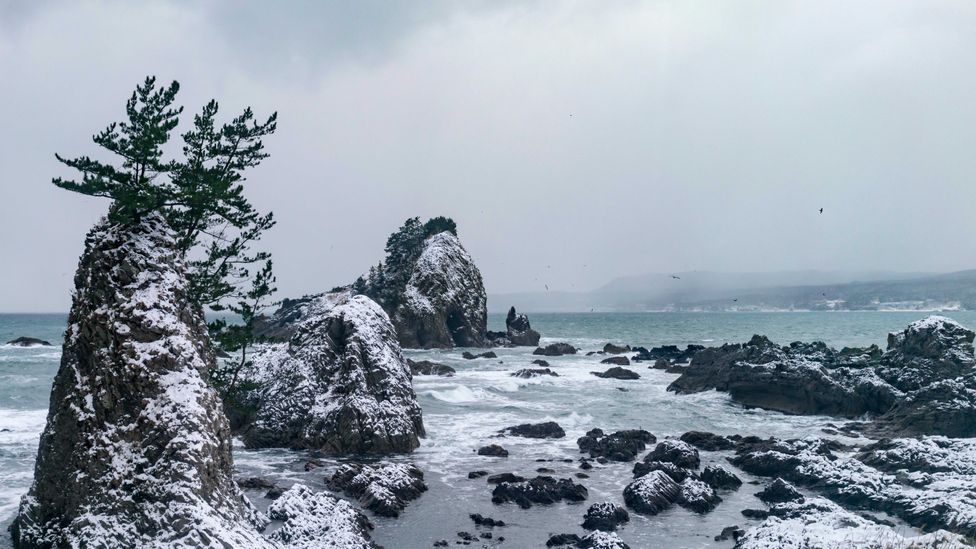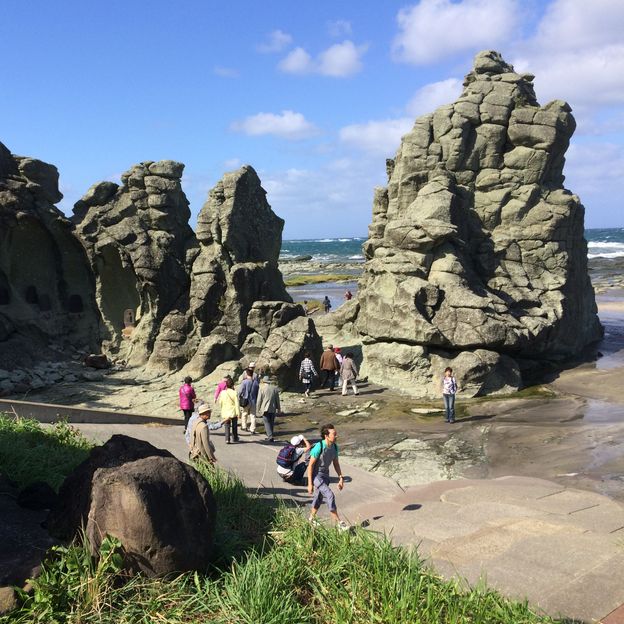Slow-motion trains beloved by the Japanese
The Japanese are obsessed with bullet trains – but they're equally smitten by those that aren't so speedy.
In Japan, the line between the creative and curious is a fine one, and that morning at 08:49, my train was running late. Late by Japanese standards, if only three minutes in real time.
As absurd as it sounds, such inconvenience can cause outcry in a clockwork-run country like Japan. At Tokyo's Shinjuku Station, the world's busiest, officials have been known to issue written apologies, with conductors falling to their knees in atonement if services depart late or even early. Drivers have also been penalised for falling behind schedule.
When my train finally arrived, however, four minutes later at 08:53, every Japanese passenger on the platform softly applauded.
This was the first of many peculiarities about my experience on board the Resort Shiakami Train, which crawls along the Gonō Line through Akita Prefecture in northern Honshu's Tōhoku region. Slow by anyone's standards, it's a train purposely built for travelling tortoise-like from the city of Aomori to Akita, often averaging just 10km/h. Operator JR-East (East Japan Railway Company) calls the service a "Joyful Train", and a trip on such a leaden-footed locomotive is like few other sightseeing journeys in the country.

For many Japanese, Tōhoku is a lost world, part of the country that has remained unchanged in the minds of the Tokyo elite. There is no Hello Kitty theme park here. No international airport or shopping mall frenzy. There are no dazzling neon-lit Nintendo arcades, Godzilla-sized towers or robot-run hotels. No tourists, even. Here is old-fashioned Japan, pure and simple, and that's exactly why I came: to travel slow, to not watch the clock.
Besides the speed, the Resort Shirakami is unusual for other reasons. The only train to run directly along Japan's coastline, its USP is dealing in a special kind of nostalgia, and my trip on the limited-stop service was a sell-out. Three trains operate on the Gonō Line, with three return services daily, and I was on board "Kumagera". It entered service in March 2006 and is named after a black woodpecker that lives in the Unesco-listed Shirakami-Sanchi Highlands, the world's largest remaining virgin beech forest, through which the train trundles. The train also has a tangerine snub nose on the front inspired by the setting sun.
|People yearn to travel slowly in Japan. Life moves too fast and train travel should help capture a special place in time
Other quirks intrigued me, too. Whenever we pulled into a station, a xylophone jingle, reminiscent of the sound of a wind-up toy, played an arrival tune. The rose-pink couchettes could also be converted into tatami mat seating for passengers who wanted to sit cross-legged by the window to picnic. When disembarking at journey's end, we all received a certificate to commemorate the completion of the sensory-rewarding journey.

"People yearn to travel slowly in Japan," said JR-East train manager Naoki Ootomo, as our service began its skink-like crawl out of Aomori Station. "Life moves too fast and train travel should help capture a special place in time. And, of course, people love all the authentic sounds on board."
Perhaps, it is an answer you could only hear in Japan, but Ootomo was completely right. Many passengers did not just purchase tickets to see the sights of the astonishing Shirakami-Sanchi Highlands. Or to marvel at the train as it wriggled past the epic panoramas of the Sea of Japan/East Sea. They had come armed with recording devices to tape the sound of the train as it gently clinked and clacked along the tracks.
Many Japanese, as I've learned during trips crossing the country from Yakushima Island in the south to Sapporo in the north, are feverishly devoted to train travel. But while the country's most famous mode of transport, the technically brilliant shinkansen, or bullet train, is the most efficient way to get around, it is no longer fulfilling enough for the country's railway fanatics. The shinkansen is a glimpse into the future for many travellers, but for those of a certain vintage, its maximum speed – of 320km/h – takes the joy out of train travel as it should be. On the shinkansen, there is no plunge into nostalgia.

Lunch arrived – vacuum packs of pickled radish, smoked cheese and squishy dried sea pineapple from the snacks trolley – and, between window glances, I read up on many of Japan's other sightseeing trains.
First, we discovered the Sagano Romantic Train, a retrofitted steam engine that cuts through the mountains surrounding Kyoto. A favourite was Aomori Prefecture's Tsugaru Tetsudo "Stove Train", a seasonal winter express, where every compartment has a potbellied stove for cooking the dried squid that is sold on board. Japan Rail Kyushu's Aru Ressha, a fine-dining dessert train that operates from Hakata to Yufuin, is one I earmarked for later. Others were the Koshino Shu*Kura, a premium sake-tasting experience in Niigata Prefecture; and the Seibu Railway, which runs dousoukai (alumni parties) and high school reunions from its base in north-western Tokyo.
Lastly, I read about the Tohoku Emotion Train, introduced in 2013 and running the length of the Hachinohe line of the Sanriku coast. It was established as one part of the regeneration and revitalisation efforts in Tohoku, with train carriage interiors taking inspiration from the artisanal traditions of each area of the region, including sashikori textiles from Fukushima, gokin-zashi stitching from Aomori and nambu ironware from Iwate.
There was something poignant about all of these: the sense being that such trains are destinations wholly in themselves, not just means of transportation. It seemed to me as though there was a train for almost every occasion.

"One of the reasons trains have become so popular is because Japanese travel trends are shifting from a focus on the material to a focus on the immaterial," Sakurako Aoki, senior manager for Japan East Railway Company, told me. "Japanese sightseeing trains are more than simple amusement trains; they place a great importance on regional revitalisation and are created with the aim of allowing people to experience the special characteristics of each region and the hospitality of the locals."
|Japanese sightseeing trains are more than simple amusement trains; they place a great importance on regional revitalisation
|Japanese sightseeing trains are more than simple amusement trains; they place a great importance on regional revitalisation
Indeed, it wasn't hard to delight in what slipped past outside the window: the scenery was extraordinary. The railway cruised past geometric fields of furry-brown pampas grass and flowering dogtooth violets. To the left of the tracks, the lower slopes of snow-topped stratovolcano Mount Iwaki were studded with apple orchards.
But what really got passengers excited was the first glimpse of the sea. Winds whipping in across the Sea of Japan/East Sea from Siberia have formed century-old sea stacks along the Akita Prefecture coast that punctuate the shoreline like exclamation marks. When the first foaming waves appeared, passengers broke out into excitable gasps.
When trundled south, braking for prolonged photo stops along the way in towns such as Fukaura and Noshiro, the sea changing from a wash of brown to a deep smoky blue. The train creaked past basalt-red cliffs and sparkly marinas and soon the fishing villages and boat pontoons were taken over by birch forest, the couchettes falling into darkness as light struggled to flit through the trees. On this slow, sightseeing train, I learned, everyone needed to join in.
